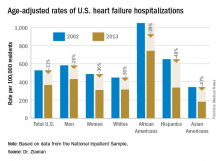ORLANDO – The disparity in U.S. heart failure incidence continued undiminished during 2002-2013, with African Americans maintaining a steady 2.3-fold increased rate of heart failure, compared with whites, based on national levels of heart failure hospitalizations, a reasonable surrogate for incidence rates, Boback Ziaeian, MD, reported at the annual scientific meeting of the Heart Failure Society of America.
The same period also showed a substantial relative improvement in the heart failure hospitalization rates among U.S. Hispanics, compared with whites, so that, by 2013, the ethnic disparity seen in 2002 between Hispanics and whites largely disappeared, reported Dr. Ziaeian, a cardiologist at the University of California, Los Angeles. The data he analyzed also showed that Asian Americans had the lowest heart failure hospitalization rates of any racial or ethnic group throughout the 11-year period, and that the incidence of heart failure fell more sharply in women than in men during the period, based on the hospitalization numbers.
Dr. Ziaeian and his associates used data collected annually during 2002-2013 by the National Inpatient Sample for patients hospitalized with heart failure as their primary diagnosis. They calculated hospitalization rates per 100,000 residents with adjustment across various demographic subgroups by age, using census data. The overall, age-adjusted, annual rate of U.S. heart failure hospitalizations fell by 31% during the 11 years, from 527 cases/100,000 residents in 2002 to 365/100,000 in 2013. This further documented a trend of falling heart failure rates that’s been reported before, he noted. What’s new are the subgroup rates his group calculated.Age-adjusted heart failure hospitalizations among whites dropped by 30%, and among African Americans by a nearly identical 29%. But this maintained a greater than twofold disparity in rates between the two groups. Among whites, the rate per 100,000 fell from 448 to 315; among African Americans, it dropped from 1,048 to 741. In 2013, the rate of heart failure hospitalizations was 2.4-fold higher in African Americans, compared with whites.
“This degree of disparity in cardiovascular disease has been underrecognized,” Dr. Ziaeian said in an interview. It indicates that, among African Americans, heart failure risk factors, particularly hypertension, “are not being adequately controlled. We know that heart failure is largely preventable, and we have guideline-directed medical therapies that can keep many patients out of the hospital.” The racial analysis is confounded by socioeconomic status, which contributes to how well Americans are treated to avoid or control heart failure.Heart failure hospitalizations fell among Hispanics from 650 per 100,000 to 337 per 100,000 in 2013, a 48% drop that brought the rate among Hispanics to nearly the same as among whites. Asian Americans remained the group with the least heart failure throughout the period, falling from 343 hospitalizations per 100,000 in 2002 to 181 per 100,000 in 2013, a 47% drop.
Among women, the age-adjusted rate per 100,000 fell from 486 to 311, a 36% drop, compared with a decrease from 582 to 431 per 100,000 in men, a 26% reduction. Lower incidence in women may reflect better risk factor control during the study period, compared with men, such as a higher rate of quiting smoking and better treatment compliance, Dr. Ziaeian suggested.
On Twitter @mitchelzoler



